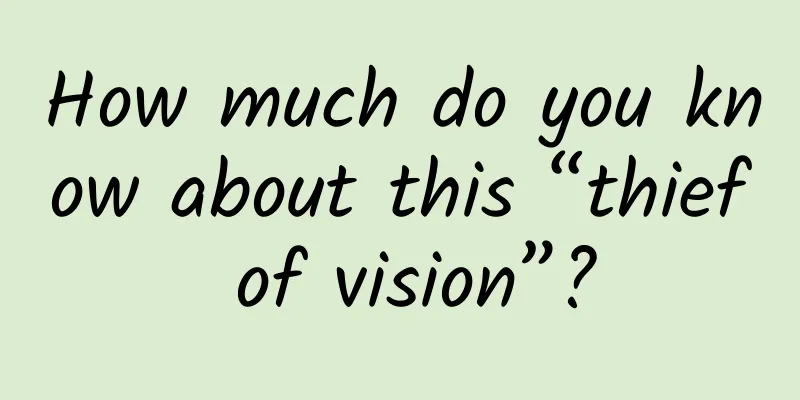How much do you know about this “thief of vision”?

|
The fast pace of modern life High frequency of mobile phone use Elderly people often keep their mobile phones in their hands Even holding a mobile phone every day Short videos can last for hours Don't turn on the lights at night Looking at the phone and computer in the dark Beware of being targeted by "eye thieves" Prevention and treatment of glaucoma in winter Cannot be ignored! What is Glaucoma Glaucoma is an irreversible blinding eye disease caused by intraocular pressure (IOP) exceeding the tolerance of the optic nerve, which causes visual impairment, optic nerve atrophy and visual field loss. Glaucoma is the world's leading irreversible blinding eye disease. Pathologically increased intraocular pressure is its main risk factor. It can occur at any age and is more common in middle-aged and elderly people. Types of Glaucoma According to the shape of the anterior chamber angle, etiology and age of onset, glaucoma can be divided into three categories: primary, secondary and congenital glaucoma. In China, primary glaucoma is the main type. Acute angle-closure glaucoma: This type of glaucoma often develops acutely, with symptoms including eye swelling and pain, decreased vision, as well as headaches, nausea, vomiting, etc. Chronic angle-closure glaucoma: This type of glaucoma does not have obvious symptoms such as eye swelling and headache, but there may be soreness and swelling at the root of the nose, large fluctuations in intraocular pressure, and iridescence (that is, when looking at a light, a rainbow-like halo appears around the light). Primary open-angle glaucoma: This type of glaucoma has a hidden onset and may not have any obvious symptoms in the early stages. It is only discovered when it develops to the middle and late stages, when the optic nerve is severely damaged, vision is reduced, and visual field damage is obvious. Therefore, this type of glaucoma requires more vigilance! What are the risk factors for glaucoma? 0 1 Glaucoma has certain genetic factors . People with a family history of glaucoma have an increased incidence rate. If a first-degree relative such as a parent, brother, or sister suffers from glaucoma, the incidence rate will increase by 5 to 10 times. 0 2 Patients with high myopia or high hyperopia ; 0 3 If you have a history of retinal hemorrhage , the risk of developing glaucoma will increase. It is recommended to have regular eye examinations; 0 4 Suffering from diabetes, cardiovascular system diseases, snoring and other diseases; 0 5 Long-term use of glucocorticoid drugs; 06 Personality and psychological factors such as high mental stress , frequent and drastic changes in negative emotions. Symptoms of Glaucoma At present, the public's awareness of glaucoma is low, and the early symptoms of the disease are easily ignored. Many patients do not seek medical treatment until their vision is significantly reduced in the middle or late stages. Glaucoma patients may experience the following symptoms: 0 1 Iridescence phenomenon occurs When you look at lights at night, a rainbow-like halo appears around the lights . This rainbow halo is medically known as the "iris vision" phenomenon. It is accompanied by a decrease in vision and is one of the typical symptoms of glaucoma. It is recommended to seek medical attention as soon as possible. 02Vision declines in a short period of time This situation is more common at night. Some people think it is just visual fatigue when it happens. After a night's sleep, they find that their vision has recovered and they think everything is fine. In fact, this is a manifestation of glaucoma attack . If treatment is delayed, an acute attack will occur and the best time for treatment will be missed. 03Headache, nausea and vomiting, eye pain It is the most typical symptom of an acute attack of glaucoma. It cannot be relieved by taking painkillers. Some people mistakenly think that it is caused by headache and go to the neurology department for treatment. It is eventually discovered that the headache is caused by glaucoma . Acute increase in intraocular pressure can cause irreversible damage to the optic nerve in a short period of time. 04No symptoms Chronic angle-closure glaucoma and primary open-angle glaucoma may not have any symptoms . Some people only have mild eye swelling, soreness and swelling at the root of the nose, etc. , especially normal-tension glaucoma, which has almost no symptoms. Therefore, not all types of glaucoma have obvious symptoms. People with high-risk factors should have regular eye examinations . If they have risk factors such as high myopia, snoring, and low blood pressure, they should go to the ophthalmology department to check for glaucoma every year to avoid delaying the disease. The glaucoma specialist at Wuhan University Aier Eye Hospital reminds that because some glaucoma (open-angle and chronic angle-closure) symptoms are atypical, most patients do not pay enough attention to them. When they are diagnosed, they are often in the middle or late stages. At this time, the optic nerve has often atrophied and visual field defects have occurred, missing the best time for treatment. Therefore, it is recommended that everyone, especially the middle-aged and elderly, should have an eye health check-up every year to screen in time and detect and treat early. Special statement: This article is only for health science popularization, not for any commercial advertising purpose, and does not replace hospital examination and treatment. If you have related diseases, please go to a regular medical institution for treatment in time and follow the doctor's advice. If the pictures infringe, please contact us to delete them. |
>>: My myopia is only 300 degrees, why does the doctor recommend ICL?
Recommend
What to do if there is mold in late pregnancy
Candidal vaginitis can cause great pain to onesel...
How to avoid scars after caesarean section
When women are pregnant, if the fetus is in an un...
How often should you apply nail polish?
Nail polish is an indispensable item for manicure...
Can I get pregnant if I have stomach pain after sex?
Some pregnant mothers said after giving birth tha...
What does abnormal uterine echo mean?
The structure inside a woman's uterus is very...
What is instant oatmeal? How does instant oatmeal help you lose weight?
Among the various grains we eat daily, such as wh...
Live broadcast|Liu Xia from Shenzhen Children's Hospital: How much do you know about precocious puberty in children?
In recent years, affected by economic development...
How to treat black blood clots after abortion
Many people will encounter such a situation. Beca...
How many days should I take ceftriaxone after abortion?
After an abortion, a woman's vagina and uteru...
What are the benefits of drinking coconut water for pregnant women?
Coconut shoes are a fresh tropical fruit native t...
What are some tips for treating facial flushing?
For women, if the face flushes, it will have a se...
Does a 50mm uterine fibroid require surgery?
As we all know, uterine fibroids can be benign or...
When will the heavy snow begin in 2021? When will the heavy snow begin in 2021?
The Big Snow solar term is the 21st solar term in...









